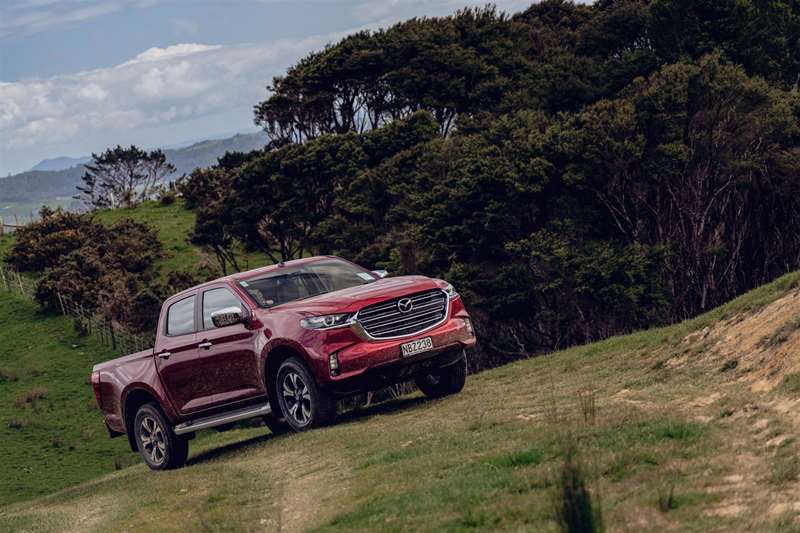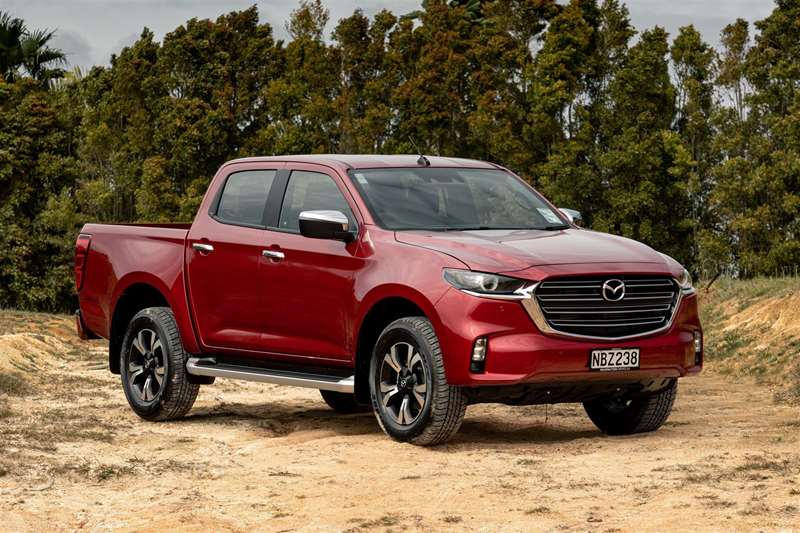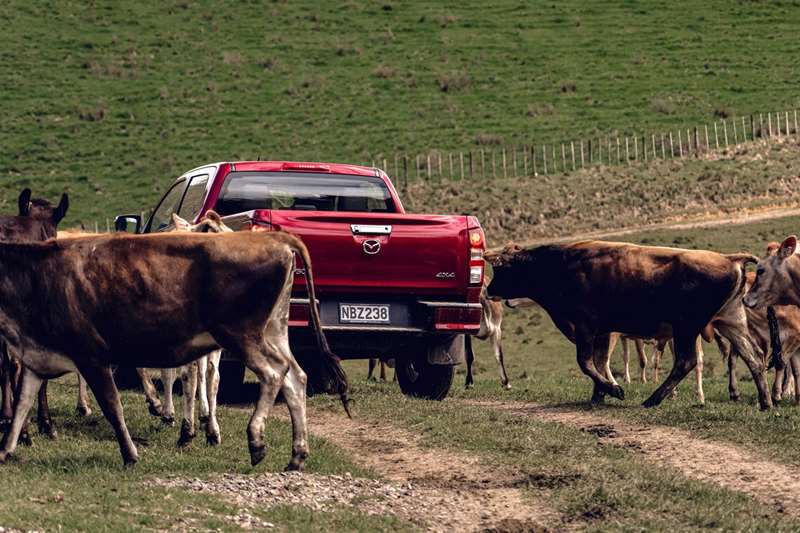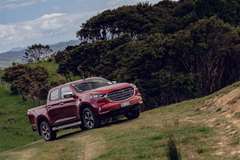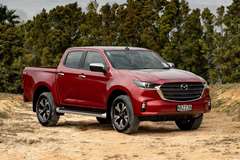David Thomson tries Mazda’s new BT-50 for size.
What’s new?
For the first two generations of its BT-50 ute, Mazda joined forces with Ford, sharing the vehicle’s core underpinnings with those of the latter company’s Ranger. The approach continues with the third-generation BT-50, but this time with Isuzu as Mazda’s chosen partner.
That’s right, the BT-50 reviewed here is a close cousin of the latest Isuzu D-Max.
Both are built on the same production line in Thailand, and both use the same underlying chassis and 3.0-litre turbodiesel powertrain. But most of the BT-50’s exterior panels are unique, giving the Mazda a look of its own.
This latest BT-50 is fractionally smaller than its predecessor, shedding 80mm in overall length and 100mm in wheelbase. Its peak outputs are also alittle less, maxing at 140kW and 450Nm, compared with 147kw and 470Nm for the model it replaces. Onthe other hand, the 3.0-litre engine that powers the latest BT-50 is a much more modern design than its 3.2-litre predecessor. Peak torque is produced across a wider rev-range than before and economy is close to 20% better.
The BT-50 lineup for New Zealand is comprised entirely of double-cab well-sides, and the only transmission choice is a six-speed automatic. Even so, there are six models on offer, split equally between two- and four-wheel-drive choices.
The 2WD line comprises the $47,490 GSX, the $51,490 GTX and $53,990 Limited, while the 4WD range carries the same three specification levels with a $7000 price premium over the corresponding 2WD model. The support package is the same as Mazda provides for its passenger cars, which means the warranty covers five years/150,000km, with fixed-price servicing for the same period and distance, and roadside assistance for five years with unlimited mileage.
I tested two 4WD models — the mid-spec $58,490 GTX and the flagship $60,990 Limited.
What’s it like to look at?
This time, the BT-50’s styling is far more assertive and quite dissimilar to that of the D-Max. There are clear links to the ‘‘kodo’’ design themes that feature across the Mazda passenger vehicle range, but this change is restrained enough to ensure nothing looks out of place. The grille treatment gives the BT-50 a strong family look that most of its ute rivals lack.
The flagship GT-50 Limited has the most extra kit, but the GTX is very well featured on the outside, too. Both sit on 18-inch alloys, boast LED running lights as well as LED head lights, and have fitted side-steps.
Across all models, the wellside compartment measures 1571mm long by 490mm deep, with a maximum width of 1530mm, and a width at the narrowest point between the rear wheel arches of 1120mm.
What’s it like inside?
Attractive, high-quality interiors have been a Mazda strength, and while the BT-50’s sharing arrangement with the D-Max requires some design compromises, the overall effect remains impressive.
The Limited is the standard bearer for the range in this regard, picking up plush trim features similar to those of a top-range Mazda passenger vehicle. These include a soft touch dash top, soft-touch interior trims for the armrests and door inserts, and artificial leather seats with perforated cushions. Brown is the dominant trim colour on the Limited, integrating with a dark headliner to give the cabin a classy look. The GTX, like the GSX, takes black cloth upholstery with a light-coloured headliner and the cabin is a cut above the light commercial norm.
The move to a shorter wheelbase costs the new BT-50 some rear room but the space is bright and airy and the rear door is wide for easy access.
My test included a three-hour open-road trip with an adult in the back, and time with the back seat backs folded up to accommodate cargo. The vehicle was entirely satisfactory in both roles.
Up front, the design of the BT-50’s dash is quite different to that ofthe D-Max. It’s an attractive piece of work with a centre colour touchscreen, flanked by two air vents, as the focal point.
Both the GTX and the Limited take the 9-inch touchscreen (the GSX gets a smaller 7-inch screen), which impresses for its clarity. The ICT system deployed on the BT-50 comes from Isuzu. It is easy to use, and boasts features such as wireless Apple CarPlay connectivity that are new to Mazda.
The front of the cabin is replete with storage options.
I tested the mid-spec GTX before the Limited, and this ute impressed for the comfort of its front seats and, in particular, the excellent adjustable lumbar support. The Limited’s front seats are better yet, with both taking seat heaters, and the driver’s is equipped with an eight-way power adjustment.
The view from the driver’s seat is commanding, the main instrument cluster (which includes a 4.2-inch LCD display) is clear, and all key controls and switchgear are logically positioned.
What comes as standard?
Both the GTX and Limited feature remote keyless entry, dual-zone climate control, satellite navigation with speed-limit recognition, and smartphone mirroring (wireless only for Apple devices). Front and rear USB plug-points are provided along with front AUX and 12v sockets. The GTX takes a six-speaker sound system, while the Limited its equipped with the premium eight-speaker system.
Safety is a strong point — both vehicles easily achieved the maximum possible five-star Ancap safety scores.
It’s to Mazda’s credit that the same safety suite is provided on every model in the range, and the list of features it covers is comprehensive. Key items include eight airbags, autonomous emergency braking, stop/go adaptive cruise, blind spot detection, lane departure warning/assist, forward collision avoidance, drive attention warning, automatic high-beam lights, rain-sensing wipers and a reversing camera.
What’s it like to drive?
It’s important to note when considering the new BT-50 that its predecessor missed out on much of the incremental development applied to the Ford Ranger over its life. As a result, the step-up between the old and new BT-50 is significant.
The most apparent gains are in refinement, including a marked reduction in both wind and tyre noise. Greater attention has also been paid to areas such as door sealing and the use of noise-deadening materials. These upgrades combine with an engine which, while obviously a diesel in its soundtrack under load, is notably refined when cruising. Ride quality has also improved —sure, there is a little jiggle when travelling lightly laden but that’s ute-normal, and settles down when there’s a decent load in the tray. On-road handling is also good by class standards, with the steering (light but accurate) well-sorted, and decent turn-in and balance through bends.
In real-world motoring the BT-50 also makes up for its slight on-paper deficit in-power and torque, through the accessibility of the torque. The full 450Nm is unleashed with a nudge of the throttle from just 1600rpm, and sustained through to 2600rpm, giving plenty of punch for conquering steeper hills or completing snappy overtaking.
The torque characteristics of the engine and calibration of the highly accomplished automatic transmission should also make the new BT-50 a solid towing car; it is rated to haul 3200kg braked as well as having a payload capacity of 1050kg to 1080kg depending on the variant.
With high-ratio 4x4 selectable on the fly, and a further twist of the appropriate knob when in neutral engaging low-ratio, switching between drive modes is straightforward. Rear difflocking and hill descent control are also provided.
The GTX was put through its paces to a limited extent on a sometimes heavily rutted dry-weather track. It was surefooted throughout, and its traction capabilities never stretched. The 240mm of ground clearance proved entirely adequate.
The on-paper promise of a significant economy gain over the old model was realised on test, with an 8.3l/100km return achieved behind the wheel of the Limited, this figure being encouragingly close to the vehicle’s 8.0l/100km standard combined cycle rating.
Verdict
The new BT-50 is an impressive addition to this country’s light commercial ranks. Combining pleasing styling with considerable dynamic prowess, a top-flight safety package and competitive pricing, it should pose a serious challenge to the current bestsellers in its class.
